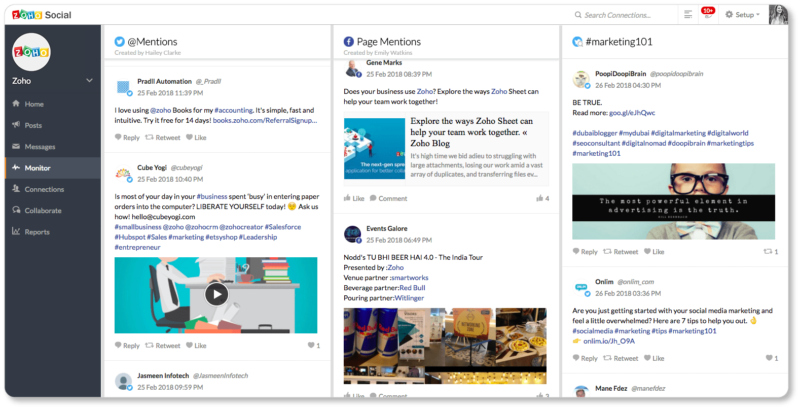We’ve been harping on the importance of regularly publishing new posts to your blog and maintaining a consistent online presence for your business. This may feel like an overwhelming thought: one post (or more) a week… for as many years as I’m in business?!
 Sure, when you think about it over the long term like that, it’s bound to sound daunting. But consider the broad range of conversations you have—with your employees, with your clients, with colleagues in your industry, and even with yourself in your own head—over the course of a week. That’s a lot of spoken (and unspoken) words. Much of that may very well be post-worthy. It’s simply a matter of being open to the possibility that the words you exchange in conversation are valuable enough to be published in print.
Sure, when you think about it over the long term like that, it’s bound to sound daunting. But consider the broad range of conversations you have—with your employees, with your clients, with colleagues in your industry, and even with yourself in your own head—over the course of a week. That’s a lot of spoken (and unspoken) words. Much of that may very well be post-worthy. It’s simply a matter of being open to the possibility that the words you exchange in conversation are valuable enough to be published in print.
Indeed, we can’t think of an industry in which you’d ever run out of things to write about. (If you did run out of ideas it would have to be because your customers or prospects had run out of questions or challenges).
But in case you find yourself feeling at a loss some weeks, here are some strategies to keep you creating new and relevant content:
Ask your readers
Your readers are an invaluable source of good ideas. What topics do they want you to discuss? What questions do they want you to answer? What do they want to hear more of? You could ask this through a blog survey that your customers respond to directly in the comments; or you could create an online survey that readers link to from your blog.
You could also simply pose questions in response to individual comments on your posts (“I’m so glad to hear this content was helpful, David! Is there anything else about the topic you’d like me to cover in a future post?”) This latter strategy is a way of cultivating community—an element of your blog absolutely worth considering.
Respond to your customers
Search your email correspondence (or chat archives, or Facebook messages, or recorded phone conversations… anywhere that you might find a trail of inquiries, objections, or other concerns). Customers and clients have probably posed their questions and expressed their frustrations in each of these places. Your customer service team probably has a list of the most common customer concerns in their heads; and it’s worth having them log each new question as it comes in. Your blog posts could be longer answers to the questions or expressions of interest that you regularly get from your own customers.
Crowdsourcing
Searching through social media will open you to a world of topics in your industry or niche to write about. You’ll eventually be promoting your own content there anyway, so why not begin there?
You can use hashtags to search within Facebook, Instagram, Twitter, Pinterest, and even LinkedIn. Hashtags will tell you what’s trending in your industry; and the juxtaposition of otherwise disparate posts and images will give you ideas for unique angles on the topic. One suggestion we’ve seen is to hashtag your industry with the word “problems” tacked to the end of it (#hairproblems, #webdesignproblems, etc):



Comb through your social networks regularly to learn about the kinds of challenges customers and prospects are experiencing, the conversations they’re having about your industry, and what they’ve got to say about the product or service your business provides.
Zoho Social, Google Alerts, Mention, and Social Mention are among the tools that allow you to track mentions on social media sites, including Facebook, Twitter, Instagram, LinkedIn, Google+, and YouTube. With all of these platforms, you can set up email notifications for a variety of keyword terms—including your business name, industry, product names, and competitors—so you’ll be notified anytime the platform finds a mention of these words:

Buzzsumo, Quora, Google Trends, Yahoo! Answers, and Answer the Public are other valuable platforms for content creators. They let you know what’s trending and what people are asking. All contain search functions where you can enter keywords for your industry.
Keep up on your industry
Stay attentive to what’s happening in your field. You can do this with the social media monitoring tools we just mentioned, or by subscribing to the most important blogs, magazines, or journals in your industry. When something is published about your industry—new technologies, new solutions, new studies, new stories about what your competitors are currently up to—your next blog post can respond to this news item.
When your readers see that you’re plugged in, they’ll respect your interest and engagement in the field beyond your own business and perceive your company as forward-looking.
Join an online community
There’s one for your industry out there—we promise. And there’s also Reddit, which hosts an online community—a subreddit—for just about every subject you can think of. (You can watch a great intro video here if Reddit is new to you.)
If we were a plumbing service, for instance, we’d definitely consider joining the Ask A Plumber subreddit, which would give us some ideas for future blog posts. Of course we’d answer the questions—more briefly—on the forum first, as a way of engaging with this particular community:

There are many benefits to joining an online community—beyond the fact that you don’t have to leave your house to be active in one! If it’s hosted on a well-known platform like Reddit, you’ll see international queries and get an international perspective. And if it’s a platform whose community members can rate questions, you’ll always know when you’re answering the most popular questions.
What’s more, an active online community will keep you in the know about what’s happening in your field. It will probably also challenge some of your existing views and broaden the lens through which you view certain facets of your industry. More raw material for blog posts? Absolutely.
Use your competitors to kindle ideas
Don’t be afraid to keep up with what your competitors are up to (assuming they’re doing it well) and take tips from what works for them.
That’s not to say you should copy what your competitors (or the companies you aspire to be like) are writing. But if you see a post of theirs called “Top 8 Questions to Ask a Web Designer Before You Sign a Contract,” and it’s gone totally viral, you might very well consider a post of your own called “5 Things You Wish Your Web Designer had Known about Your Business from the Beginning.”
Of course, those “5 things” will be your own, and unique to your business—you won’t be taking from the “Top 8” your competitor listed. The point is that the headline and the concept will mirror something you know worked well.
Update older posts
Occasionally something happens in your industry, or in the news, that makes an older post worth updating in light of recent events. Revise the contents, play with the title, and repost—and you’ll breathe new life into a post that otherwise would have begun to feel stale for your readers.
Here’s an example from the blog at the Milwaukee Art Museum. The post was updated after the museum acquired the art piece it was initially about:


The advantage to updating old posts (particularly the more popular ones) rather than simply writing new posts is that you get the benefit of the original post’s accumulated SEO juice. Google already recognizes it as a popular post; and because you’ve switched the time stamp on the post from “published on” to “updated on,” it now also sees that you’re committed to keeping your blog posts fresh and up-to-date.
If you need more proof about the importance of republishing older posts, you can watch Rand Fishkin at Moz explain why Google rewards republishing, or read Neil Patel’s article on “Why Your Best Blog Posts are Also the Oldest.” Neil also offers strategies for updating your blog content, as does Tom Demers at Search Engine Journal.
Repurpose older posts
Repurposing is different from updating, insofar as you leave the original blog post untouched. At some point you’ll have a sense of what your most popular posts are (Hint: They’ll be the ones with the most comments or the most shares). Go in and imagine how you might rehash those posts in other formats. Maybe your copy is also the raw material for an infographic, or a case study, or a slideshare, or a video post.
What’s so great about the multimedia strategy is that it broadens your audience base. Subscribers who weren’t willing to read that particularly long post might be more willing to consume the idea in an infographic. Visitors who didn’t have time to read your content can now hit “play” on a YouTube video and listen as they clean their house.
Repurposing is a great strategy for the weeks you simply don’t have the time or energy to write a post. The material is already there, and repurposing may take only a matter of minutes.
Neil Patel and Aaron Agius offer some very useful repurposing strategies at Quick Sprout, as does Megan Marss at Wordstream.
Pro tip: This multimedia approach can also work when updating your posts. Maybe you make a two-minute video in which you discuss what it feels like to reread this post a year, two years, after you wrote it: What’s changed in your industry since you wrote that first piece? Has your opinion on the matter shifted at all? And so on. These reflections can be quick, but very useful for your readers.
Assign posts to other people in your company
Okay, this doesn’t exactly fall into the category of generating your own new post ideas. Rather, it lets you hand over the work of idea-generation to someone else for the day. It also doesn’t exactly fall under the category of guest-blogging; but it offers one comparable advantage: It will add a new voice to your blog and provide readers with some variety to keep them engaged.
It also lends a tone of authority to the topic that you yourself may not be able to give, since the employees who write these posts will write about the topics they specialize in… and will have something to talk about that you may not have thought of.
The best writer on your IT team will probably write on technical topics; the best writer on your customer service team will likely take on a question they receive regularly and have become particularly adept at answering. You get the point.
This is not to suggest that you ask your employees to step too far outside of their job descriptions. But if they’re willing to sit down and write some words for the company blog about the topics they’ve mastered (and the things prospects and customers want to know about), let them release you from an hour or two of blog post writing. They might appreciate a break from their usual routine as well.
Marcus Sheridan at The Sales Lion offers a compelling list of reasons why “employees SHOULD be required to participate in blogging and content marketing.” Segue Technologies is one business that recognizes the importance of doling out posts to employees whose technical expertise matches the posts’ content. (Note that their “agile evangelist” is the one writing about agile disciplines):


Privileging quality over quantity
If it were up to us, you’d post at least once a week… and possibly more. But this doesn’t mean you should privilege consistency to the detriment of quality. Even if they’re only published sporadically, are your posts answering your prospects’ and customers’ questions? Are they exploring issues pertinent to your customers’ pain points and challenges? These are the questions you should be regularly asking and answering for yourself.
Finally, remember that blogging is just like any other skill: It improves with practice. In other words, the quality will come with quantity. Maintaining a regular blogging routine necessarily means you’ll become a better writer over time. This is of great value—not only for your blog, but also for every other kind of content you’ll have to write for your business.
So that’s our shortlist of strategies for coming up with blog content. But once you’ve got the ideas—or even the written material—and you’re ready to put it together, how do you make sure that you’re giving your readers variety over the long term? In the next section, we offer a variety of “blog types” (think of them as genres-within-the-genre) that will keep you thinking creatively when you sit down to draft your posts.
